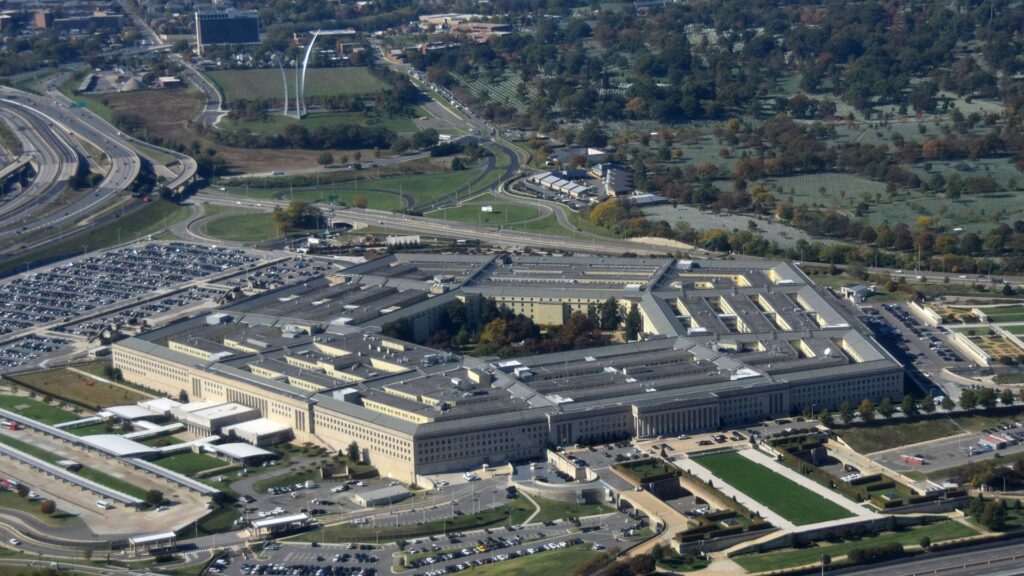The US economy is in reasonably good shape, according to conventional measurements. The official unemployment rate is below 4%, and the productivity of US workers is surging. In the last quarter, economic growth was nearly 5%, and inflation has been leveling off. Americans are buying things, throwing parties and going on vacations.
Last year, economists were predicting a recession. It hasn’t happened; not yet, at least. In part, that’s because the United States, like many other countries, is still enjoying a rebound from the worst of the Covid pandemic. Led by India, China and Indonesia, the global economy is on pace to grow about 3% this year, which also provides America with a tailwind.
Biden increases both military and domestic spending
The major challenge for the United States is the perennial trade-off between guns and butter. Right now, the Biden administration has turned this dilemma of “either-or” into “both-and” by increasing spending on the Pentagon while priming the pump of the domestic economy. So, the question now is: How long can this increase in spending on both military and non-military sectors of the economy continue?
Since the withdrawal of troops from Afghanistan in 2021, the United States has not been directly engaged in any major wars. It still conducts air strikes in Syria and maintains a contingent of a couple thousand troops in Iraq. About 170,000 US soldiers are active on hundreds of overseas bases, with the largest concentrations in Germany, Japan and South Korea. But the era of significant “boots on the ground” in active conflicts is, at least temporarily, over.
Yet, paradoxically, US military spending is at an all-time high. From 2017 to 2023, the Pentagon’s base budget increased by over 50%. For 2024, overall US military spending — which includes the allotment for the Pentagon, the budget for nuclear weapons at the Department of Energy and a few other items — will be $886 billion. With supplemental requests, like the current one for Ukraine and Israel, the total will approach $1 trillion, the highest military spending since World War II.
Only 15 governments in the world have larger overall budgets than what is currently allocated to the US military. That, in itself, is a staggering statistic.
At the same time, the Biden administration has been pushing through very large expenditures on the domestic economy. In 2021, in its first major win, the administration won passage of a $1.9 trillion stimulus package to respond to the Covid pandemic. It followed up the same year with a $1 trillion infrastructure bill. The next year, the Inflation Reduction Act provided several hundred billion dollars in climate-related funding. The administration also set aside over $50 billion for investments in the semiconductor industry.
That’s a lot of government spending on the “butter” side. Given the lamentable state of US infrastructure, the economic inequities that are baked into the system and the overwhelming need to construct a modern, sustainable economy, investments on the domestic side are critically needed. Of course, some of that spending is offset by revenue generation through additional taxes and other measures.
But along with all the military spending, the administration’s investments into the domestic economy have contributed to the US budget deficit, raising it from $1.37 trillion in 2022 to $1.7 trillion in 2023. The overall debt, which is the accumulated total of deficits over the years, now stands at around $33 trillion. That’s the value of the economies of China, Japan, Germany, India and the UK combined.
The percentage of debt to GDP for the United States is around 123%. Other countries, especially Japan, are in worse situations. Governments in the Global South that face that kind of ratio are usually considered in a debt crisis. The United States gets a pass because the dollar is the global currency. The federal government can either raise taxes, issue more bonds or print more money to cover the gap between revenues and expenditures.
Still, at a certain point, the United States will have to choose between its addiction to military spending and the economic demands of its population.
What is the US spending so much money on?
Although the United States is not directly engaged in an active conflict, it is sending a lot of support to Ukraine in its battle against Russian occupation forces. Total military assistance is close to $50 billion. The Pentagon has sent over so much military hardware that it has depleted its own stocks. That’s one reason the United States has persuaded South Korea to send over military assistance on top of the nonlethal support that Seoul is providing.
It’s also why the Biden administration has proposed a $105 billion supplemental bill, of which $61 billion is slotted for Ukraine. A huge portion of that $61 billion — $44 billion — would actually go to the Pentagon to replenish its stocks for the eventual resupply of the Ukrainian army.
The supplemental also includes money for Israel, for Taiwan and for further militarizing the border between Mexico and the United States.
Although the military assistance for Ukraine dominates the headlines as well as the battles in Congress, the bulk of US spending actually goes to big-ticket items — ships, planes, space weapons — that have little to do with the war between Moscow and Kyiv.
Indeed, the United States has engaged in a multi-year reorientation of military policy toward Asia. Some part of that reorientation has been to counter North Korea. But aside from its nuclear weapons, which are very difficult to defend against, the Pentagon isn’t really worried about Pyongyang. Although North Korea has a large army, it is largely ineffectual, which explains why Pyongyang has invested so heavily in acquiring a nuclear deterrent.
The Pentagon’s real concern is China, particularly its interest in absorbing Taiwan and extending its control over the South China Sea. China has the only military in the world that comes close to matching the Pentagon’s might. Increasing its military spending by about 7% annually over the last few years, China has been incrementally closing the gap.
The United States and China face a challenge. Will they continue to spend heavily on their militaries and risk not only war but bankruptcy, political instability and economic stagnation at home?
This is no small issue. To deal effectively with the threat of climate change, China and the United States must not only cooperate but also free up funds to help the rest of the world make an equitable transition away from fossil fuels. Yes, it is theoretically possible for the United States and China to continue to invest heavily into both guns and butter even while avoiding war and economic collapse.
But the planet can’t afford that strategy.
[Foreign Policy in Focus first published this piece.]
The views expressed in this article are the author’s own and do not necessarily reflect Fair Observer’s editorial policy.
Support Fair Observer
We rely on your support for our independence, diversity and quality.
For more than 10 years, Fair Observer has been free, fair and independent. No billionaire owns us, no advertisers control us. We are a reader-supported nonprofit. Unlike many other publications, we keep our content free for readers regardless of where they live or whether they can afford to pay. We have no paywalls and no ads.
In the post-truth era of fake news, echo chambers and filter bubbles, we publish a plurality of perspectives from around the world. Anyone can publish with us, but everyone goes through a rigorous editorial process. So, you get fact-checked, well-reasoned content instead of noise.
We publish 2,500+ voices from 90+ countries. We also conduct education and training programs
on subjects ranging from digital media and journalism to writing and critical thinking. This
doesn’t come cheap. Servers, editors, trainers and web developers cost
money.
Please consider supporting us on a regular basis as a recurring donor or a
sustaining member.
Will you support FO’s journalism?
We rely on your support for our independence, diversity and quality.










Comment